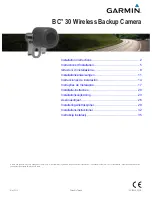
Top left: To rewind the film after exposure, depress the reversing button in the base of the camera. Top centre:
Turn the rewind knob to rewind the film into its cassette. Top right: Open the camera back (see page 14).
Bottom left: Pull up the rewind knob. Bottom centre: Remove the cassette from the film chamber. Bottom right:
Close the camera back again, or reload with a new film. See also page 22.
Cutting off Exposed Film Parts
If a film which is only partly exposed has to be processed, it can be cut off In the darkroom or in complete darkness.
After the last exposure the film transport should be wound on once more (this in the dark), the camera back opened
and the film cut about ½ in. away from the cassette. The exposed part on the take-up spool is removed by pressing
the reversing button, winding the film from the take-up spool and wrapping it up in three layers of black opaque
paper. The remaining film in the cassette can now be re-inserted on the take-up spool (the reversing button
automatically jumps out on actuating the rapid winder), and the camera closed. If the re-inserting has been done in
the darkroom no further blind exposure is necessary; if the film has been re-inserted in daylight, two blind
exposures should be made. The exposure counter should be advanced by two to allow for the loss of film in cutting
and re-inserting.
The process is virtually the same with pre-1952 Retinette models, except that the reversing lever (instead of the
button) and the film transport knob (instead of the lever) are operated.
Changing Partly Exposed Films
To replace a partly exposed film by another one -- for instance, if you want to take a few colour photographs in
between some black-and-white shots -- proceed as follows.
1. Check number of unexposed frames shown on film counter.
2. Rewind film.
3. Unload.
4. When reloading:
5. Load film in camera.
6. Close back.
7. Set film counter to starting point.
8. Depress film release while winding film on.
2. When rewinding the film be careful to wind only until you feel some resistance. In the ordinary way this resistance
would have to be overcome in order to pull the film end from the take-up spool. If the film is to be reloaded again,
you must not pull the whole film into the cassette, otherwise the film end will have to be extricated by opening the
cassette in the darkroom for subsequent re-insertion into the camera.
3. Take the re-wound film out of the camera. For reference, note the number of exposures still left on the film and
write this number on the label of the cassette. Then put it into a container or wrap it up. Now you can load the
camera with any other type of film.
7. Do not press the shutter release button when you wind on (this would open the shutter and expose the already
exposed frames). Press film release and wind the rapid wind lever until the required number (the next unexposed
frame) appears in the film counter.
Early Retinette models and also the latest, have no film release, and you have to cover the lens while advancing the
film, exposure by exposure, as you release the shutter each time.
The Film Release of the Retinettes
Apart from its application in changing partly exposed films (see above), the film release, where fitted, helps to free
jamming which may lock the mechanism of the rapid winder. Simply depress this button to clear the winder, without
losing a frame or risking a double exposure. If pressure on the film release does not release the winder, this
automatically indicates that the end of the film has been reached.
Similarly, if you did not set the exposure counter when loading you may reach No. 1 on the exposure counter before
the end of the film is reached. At No. 1 the rapid wind lever automatically locks. By pressing the film release lever
you can re-set the exposure counter, which at the same time will free the winding lever. Should the winding lever
stick in a between position, press the film release button on the base to make it spring back.
Double Exposures
The double-exposure lock of the Retinettes prevents accidental double exposures. To make a deliberate double
exposure for special purposes, press the reversing button after the first exposure, and keep it depressed while
tensioning the shutter with the rapid winding lever. The film then remains in position for a second exposure on the
same frame. Note that operating the rapid winder after the second exposure also advances the film counter to
indicate one frame more than the number exposed.
On pre-1952 Retinette models the double-exposure lock blocks the release button only. To make deliberate double
exposures, re-tension the shutter by means of the tensioning lever, and release by pressing the release lever on the
front of the shutter itself.














































